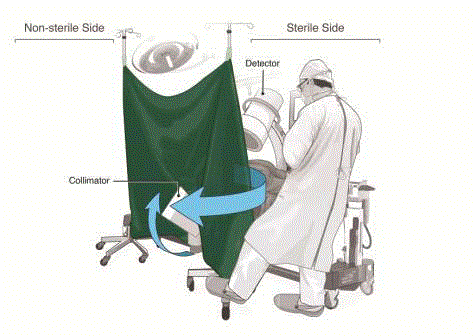Case Report
C-Arm Drape during Spine Surgery: A Practical Technique
Mohammed Bangash*
Department of Neurological Surgery, Department of Surgery, King Abdulaziz University, Saudi Arabia
*Corresponding author: Mohammed Bangash, Department of Neurological Surgery, Department of Surgery, King Abdulaziz University, PO Box 42806, Jeddah 21551, Kingdom of Saudi Arabia
Published: 27 Sep, 2017
Cite this article as: Bangash M. C-Arm Drape during Spine
Surgery: A Practical Technique. Clin
Surg. 2017; 2: 1639.
Abstract
In spine surgery, often there is a need for intraoperative fluoroscopy through a mobile machine that
may be a challenge in keeping the surgical field sterile. The aim of this article is to describe a new
technique that may facilitate the draping issue during spine surgery.
Material and Method: A mobile draping method is described with a simple readily available
material.
Conclusion: the described technique may save time and reduce the cost of spine surgeries that
require c-arm fluoroscopy.
Keywords: C-arm drape; Spine surgery; Technique
Background
Postoperative wound infection usually results from bacterial contamination during or after a
surgical procedure. The aseptic technique has developed significantly in the last century. As well
as, the spine instrumentation procedures have been advancing tremendously. This advancement
increases the need for strict sterile techniques.
The use of surgical drapes has developed as a standard of practice. Their main purpose is to
protect sterile surgical field from microbial contamination. Reusable woven fabrics had been used
universally as aseptic barriers since the turn of the century.
In spine surgery the use of surgical drapes is as important as in other surgeries. However, in spine
surgery, often there is a need for intraoperative fluoroscopy through a mobile machine that may add
another challenge in keeping the surgical field sterile. The intraoperative fluoroscopy requires the
change in position between the antero-posterior (AP) and lateral views. With each change, new
drapes need to be applied to the part of the machine near the room’s floor. This may increase the
risk of surgical site infection (SSI) [1], consume time and resources especially in minimally invasive
spine surgery (MIS) where the fluoroscopy images are essential for the procedures. The aim of this
article is to describe a new technique that may facilitate the draping issue during spine surgery.
Material and Method
The idea is to have a mobile drape that has two sides; an inner one facing the sterile field and an outer one facing the contaminated environment. Two intravenous poles are required. After prepping the surgical field, a sterile draping sheet is hanged between the two poles using a couple of sterile clamps at the upper part. The circulating nurse can reinforce the lower part of the sterile sheet by adhesive tape. As the fluoroscopy machine is moved from AP position to lateral position the mobile drape can be moved toward the sterile field by controlling the wheels of the IV pole with the surgeon foot (Figure 1). As the machine in the final lateral position, the drape can be adjusted by the same foot control method to accommodate the surgeon to work while taking the x-ray. To go back to the AP position, the machine can be moved in the position and the mobile drape can be pushed away to be ready for the next lateral view.
Figure 1
Figure 1
The mobile drape with two sides and rotating axis for both the
drape and the C-arm. The surgeon controls the position of the drape with
one foot.
Discussion
SSI after spine surgery is a well-known complication that can result in poor outcomes [2].
The incidence of SSI after clean spine is estimated between 1 to 10% [3,4]. Accordingly, the spine
surgeons are very meticulous regarding the SSI. It has been shown that prolonged spine surgical time
can increase the patient’s morbidity and poor outcome [5-7]. So, to have a balance between surgical
time and strict sterile technique may be of benefit. On the other hand, decreasing the number of
opened sterile drape with each change in the position of the c-arm will be more cost effective. A
similar study addressed the same problem and advocates to use the pouch technique (armor), the issue of that technique is that it is fixed to the drape of the table and
multiple levels spine surgery, more than one drape needs to be used.
This article is based on a single surgeon experience with no
available data to support this technique. A prospective study needs
to be conducted in order to test this technique effectiveness from the
infection control point of view.
Conclusion
Mobile c-arm drape is an option in spine surgery that may save time and cost of the procedure.
Acknowledgement
The author likes to thank Emily MacDougal for her artistic work in this article.
References
- Biswas D, Bible JE, Whang PG, Simpson AK, Grauer JN. Sterility of C-arm fluoroscopy during spinal surgery. Spine (Phila Pa 1976). 2008;33(17):1913-7.
- Cizik AM, Lee MJ, Martin BI, Bransford RJ, Bellabarba C, Chapman JR, et al. Using the spine surgical invasiveness index to identify risk of surgical site infection: a multivariate analysis. J Bone Joint Surg Am. 2012;94(4):335-42.
- Anderson PA, Savage JW, Vaccaro AR, Radcliff K, Arnold PM, Lawrence BD, et al. Prevention of Surgical Site Infection in Spine Surgery. Neurosurgery. 2017;80(3S):S114-S23.
- Abdul-Jabbar A, Takemoto S, Weber MH, Hu SS, Mummaneni PV, Deviren V, et al. Surgical site infection in spinal surgery: description of surgical and patient-based risk factors for postoperative infection using administrative claims data. Spine (Phila Pa 1976). 2012;37(15):1340-5.
- Boston KM, Baraniuk S, O'Heron S, Murray KO. Risk factors for spinal surgical site infection, Houston, Texas. Infect Control Hosp Epidemiol. 2009;30(9):884-9.
- Mahesh B, Upendra B, Vijay S, Kumar GA, Reddy S. Complication rate during multilevel lumbar fusion in patients above 60 years. Indian J Orthop. 2017;51(2):139-46.
- Kaska SC. A standardized and safe method of sterile field maintenance during intra-operative horizontal plane fluoroscopy. Patient Saf Surg. 2010;4(1):20.

